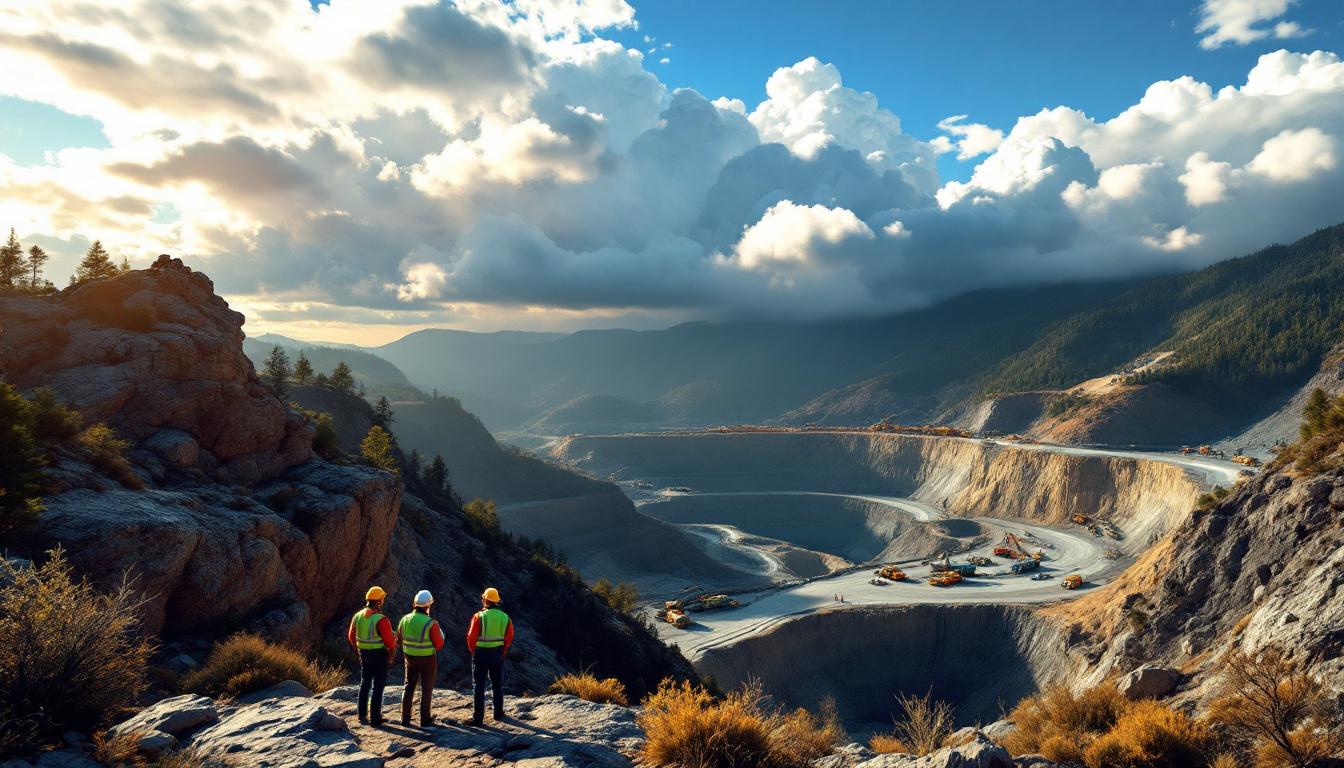Snowline's Valley Gold Project: Transforming Canada's Mining Landscape
The mining landscape in Canada is witnessing a transformative development with Snowline Gold Corp's Valley Gold Project, poised to become one of the country's most significant gold mining operations. This ambitious project combines exceptional economics with responsible development practices, setting new standards for the Canadian mining sector. Furthermore, current gold market performance suggests favorable conditions for new major mining developments.
What is the Valley Gold Deposit?
The Valley Gold Deposit represents a remarkable resource that combines scale, grade, and favorable mining conditions—a rare combination in today's mining landscape. Located in Canada's mineral-rich Yukon Territory, this deposit forms the cornerstone of Snowline Gold Corp's (TSXV: SGD) broader Rogue gold project portfolio.
Geographic Location and Project Overview
Valley is situated in the eastern portion of the Yukon Territory, a jurisdiction with increasing prominence in Canada's mining sector. The project envisions a conventional open-pit mining operation with a substantial 25,000 tonne per day milling capacity, designed to efficiently process the significant gold resources present.
The deposit hosts measured and indicated resources totaling approximately 8 million ounces of gold, positioning it among Canada's largest undeveloped gold projects. This substantial resource base provides the foundation for what could become one of Canada's premier gold mining operations, especially given the current gold price forecast indicating continued strength in the sector.
Scott Berdahl, CEO of Snowline Gold, emphasizes the project's unique characteristics: "The rare combination of high margins and large scale makes for a robust asset with stability through a wide range of market conditions."
Geological Significance
What sets Valley apart from many gold deposits is its exceptional geological characteristics. The deposit features a low strip ratio of 0.41:1, substantially lower than many comparable operations. This favorable waste-to-ore ratio significantly enhances mining efficiency and economics.
The deposit also boasts strong gold grades that contribute to favorable economics throughout the projected mine life. As Berdahl notes, "The low strip ratio and strong gold grades enhance project economics by increasing mining efficiency while reducing the overall project footprint."
These geological advantages translate to both economic and environmental benefits, allowing for a reduced overall project footprint compared to similar-sized operations—a crucial consideration for modern mining development.
What Does the Preliminary Economic Assessment Reveal?
The recently completed Preliminary Economic Assessment (PEA) for the Valley Gold Project showcases robust economics across various gold price scenarios, highlighting the project's potential to deliver substantial returns over a multi-decade operating life.
Capital Investment Requirements
The PEA outlines an initial capital expenditure estimated at C$1.685 billion to bring the Valley project into production. This investment will establish the infrastructure, processing facilities, and operational systems needed to support a large-scale mining operation.
Snowline is targeting construction readiness by 2030, allowing sufficient time for comprehensive studies, permitting processes, and engagement with stakeholders. The company is committed to a comprehensive development approach that prioritizes high operational, environmental, and social standards throughout the project lifecycle.
Production Forecasts
Valley's production profile demonstrates both impressive scale and consistency:
| Production Metric | Amount |
|---|---|
| Total life-of-mine gold production | 6.8 million ounces |
| Mine life | 20 years |
| First five years production (annual) | 544,000 ounces |
| Life-of-mine average (annual) | 341,000 ounces |
This production profile places Valley among Canada's most significant gold mining operations, with particularly strong output during the crucial initial years. The consistent production pattern supports long-term operational stability and predictable cash flows.
Economic Performance Indicators
The project's economic indicators reveal exceptional potential returns, particularly in the early operating years:
| Economic Metric | First Five Years | Life-of-Mine Average |
|---|---|---|
| All-in Sustaining Cost (AISC) | US$569 per ounce | US$844 per ounce |
At a base case gold price of US$2,150 per ounce, the project demonstrates compelling post-tax financial metrics:
- Net present value (5% discount): C$3.37 billion
- Internal rate of return: 25%
- Payback period: 2.7 years
- Average annual free cash flow: C$426 million
These figures position Valley among the most economically attractive gold projects in development globally, with particularly strong cost performance during the initial production years. Recent gold prices analysis supports the viability of these economic projections.
Sensitivity Analysis
The PEA also examines how the project economics respond to a higher gold price scenario of US$3,150 per ounce:
| Economic Metric | Base Case (US$2,150/oz) | Upside Case (US$3,150/oz) |
|---|---|---|
| NPV (5% discount) | C$3.37 billion | C$6.8 billion |
| IRR | 25% | 37% |
| Payback period | 2.7 years | 2.1 years |
| Average annual free cash flow | C$426 million | C$728 million |
This sensitivity analysis demonstrates the project's leverage to gold price movements while maintaining robust economics even at the base case price assumption.
Disclaimer: The Preliminary Economic Assessment is preliminary in nature and includes inferred mineral resources that are considered too speculative geologically to have economic considerations applied to them to be categorized as mineral reserves. There is no certainty that the PEA will be realized.
How Will Valley Compare to Other Canadian Gold Operations?
The Valley project's scale and economics position it to become a cornerstone operation within Canada's gold mining sector once developed.
Competitive Positioning
Valley has the potential to become a world-class mining operation based on multiple metrics that matter to investors, local communities, and the broader mining industry. As Berdahl states, the project will "advance an important new contributor to the Canadian gold mining landscape."
The project demonstrates robust economics across various market conditions, with particularly strong performance during the crucial early production years. This economic resilience enhances the project's competitive position in the gold mining sector.
Valley's location in the Yukon Territory also emphasizes its strategic importance to the regional mining sector, potentially establishing the territory as a major gold producing region in Canada. The project aligns with broader North American mining trends that show increased investment in premier mining jurisdictions.
Production Scale Comparison
Based on the production forecasts, Valley will rank among Canada's largest gold mining operations:
- First five years average production (544,000 ounces annually) would place it among the top tier of Canadian gold mines
- Life-of-mine average production (341,000 ounces annually) maintains significant scale throughout the 20-year operation
- Total life-of-mine production of 6.8 million ounces represents a substantial contribution to Canada's gold output
The 8 million ounce resource base provides a significant foundation for long-term operations, with potential for further resource expansion through ongoing exploration efforts.
What Steps is Snowline Taking to Advance the Project?
Snowline has established a clear development pathway for the Valley project, combining technical advancement with strategic leadership expansion.
Current Development Activities
The company is systematically advancing Valley through the development pipeline with multiple concurrent initiatives:
- Field work already underway to support the prefeasibility study, the next major technical milestone
- Environmental baseline studies in progress to establish the foundation for future permitting requirements
- Technical studies advancing simultaneously with exploration to optimize project parameters
- Engagement with First Nations communities to build lasting relationships based on mutual respect and benefit
These parallel workstreams demonstrate Snowline's comprehensive approach to project development, addressing technical, environmental, and social aspects simultaneously.
Project Timeline
Snowline has outlined a structured timeline for Valley's advancement:
- Construction readiness targeted for 2030, allowing sufficient time for thorough studies and permitting
- Phased approach to development, ensuring each step builds on previous work
- Systematic advancement through regulatory and permitting processes with appropriate stakeholder engagement
This measured timeline reflects the company's commitment to thorough planning and responsible development practices.
Leadership Expansion
Recognizing the need for experienced leadership to advance a project of Valley's scale, Snowline has significantly strengthened its management team with several key appointments:
- Calum Morrison appointed as President (former Great Bear Resources CFO)
- Rob Doyle joining as Director (former Pan American Silver CFO)
- Lauren McDougall as CFO
- Victor Vdovin as VP of Engineering
- Oliver Curran as VP of Environment and Permitting
These strategic additions bring substantial mining development, operations, and financing experience to the Snowline team. Particularly notable is the appointment of executives with experience from Great Bear Resources and Pan American Silver, companies with strong track records in project development and operations.
What Environmental and Community Considerations are Being Addressed?
Snowline is integrating environmental stewardship and community engagement as core elements of the Valley project development strategy.
Environmental Planning
The project benefits from several environmental advantages inherent in its geological characteristics:
- Reduced project footprint due to favorable geology with a low strip ratio
- Comprehensive environmental baseline work underway to understand existing conditions
- Sustainable development approach integrated into project design from the earliest stages
- Environmental assessment and permitting strategy being developed with input from experienced professionals
The company has appointed Oliver Curran as VP of Environment and Permitting, demonstrating its commitment to addressing environmental considerations with dedicated expertise.
Community Engagement
Building positive relationships with local communities, particularly First Nations, represents a fundamental aspect of Snowline's development approach:
- Ongoing consultations with First Nations to understand priorities and concerns
- Focus on creating significant economic benefits for Yukon, as emphasized by CEO Berdahl
- Potential employment and business opportunities for local communities throughout the project lifecycle
- Commitment to responsible resource development that respects community values and priorities
"Valley has clear potential to bring significant economic benefits to the Yukon," notes Berdahl, highlighting the company's focus on creating shared value through project development.
What Makes the Valley Project Economically Robust?
Valley's exceptional economic profile stems from a combination of geological advantages, operational efficiencies, and market positioning.
Key Economic Drivers
Several fundamental factors contribute to Valley's strong economic outlook:
- Exceptional gold grades contributing to high margins, particularly in the early production years
- Low strip ratio (0.41:1) substantially reducing mining costs compared to many comparable operations
- Efficient processing methodology designed to maximize gold recovery while controlling operational costs
- Substantial resource base supporting long-term operations with consistent production levels
These factors combine to create a project with strong cash generation potential across various market conditions. The current gold market outlook further reinforces the project's promising economics.
Risk Mitigation Factors
Valley's economic robustness is further enhanced by several risk mitigation elements:
- Strong economics even at conservative gold prices, with exceptional performance in the base case scenario
- Stable mining jurisdiction in Canada's Yukon Territory, with established regulatory frameworks
- Robust project fundamentals providing resilience against market fluctuations and operational challenges
- Experienced management team with track record of successful project development and operations
These characteristics position Valley to deliver value through various market cycles and operating conditions.
What Exploration Potential Exists Beyond the Current Resource?
While the existing 8 million ounce resource provides a substantial foundation for development, significant exploration potential remains both at Valley and across Snowline's broader property portfolio.
Regional Exploration Opportunities
Snowline is conducting ongoing regional exploration programs to identify and evaluate additional mineralization:
- Systematic exploration across the company's extensive Yukon land holdings
- Potential for resource expansion beyond current estimates through targeted drilling programs
- Strategic land position in a highly prospective gold district with multiple promising targets
- Integration of exploration with development planning to maximize overall project value
As Berdahl notes, "Combined with our ongoing regional exploration, we are excited by the path ahead." This statement reflects the company's dual focus on advancing Valley while continuing to explore for additional resources.
Future Growth Pathways
Several potential growth pathways could enhance Valley's already impressive outlook:
- Potential for underground mining beyond the initial open pit, accessing deeper mineralization
- Opportunities for production expansion based on resource growth or processing enhancements
- Resource growth through continued exploration of the broader deposit area
- Optimization of mining and processing methods based on ongoing technical studies
These growth opportunities could potentially extend mine life, increase production, or enhance project economics beyond the base case scenario outlined in the PEA.
FAQ About Snowline's Valley Gold Project
How does Valley compare to other global gold projects in development?
Valley stands out with its combination of scale (8 million ounce resource), grade quality, and favorable economics (US$844/oz AISC), positioning it among the more attractive large-scale gold projects globally. The project's first five-year AISC of US$569/oz places it in the lowest quartile of the global cost curve, while its 20-year mine life provides operational longevity that many projects cannot match.
What are the main risks to project development?
Key considerations include permitting timelines in the Yukon Territory, capital cost management in an inflationary environment, potential gold price volatility, and ensuring effective stakeholder engagement throughout the development process. Snowline is addressing these risks through comprehensive planning, experienced leadership, and a measured development approach.
How might the project impact gold supply in North America?
At full production, Valley could become a significant contributor to North American gold supply, potentially producing over 340,000 ounces annually for two decades. This production would represent a meaningful addition to Canadian gold output and help offset declining production from aging operations in traditional mining districts.
What infrastructure advantages or challenges does the project face?
The project's location in Yukon presents both advantages (established mining jurisdiction) and challenges (northern climate, logistics) that Snowline is addressing in its development planning. Yukon's growing mining sector has led to infrastructure improvements in recent years, though Valley will require significant additional infrastructure development as part of its capital program.
Snowline Outlines Plan for Major Canadian Gold Mine
The Valley Gold Project represents a major addition to Canada's mining landscape, combining scale, grade, and economics in a compelling development opportunity. With measured and indicated resources approaching 8 million ounces, production potential exceeding 500,000 ounces annually in the early years, and all-in sustaining costs well below industry averages, Valley demonstrates the characteristics of a world-class mining asset.
Snowline's systematic approach to advancing the project—combining technical studies, environmental baseline work, community engagement, and ongoing exploration—provides a solid foundation for future development. The company's expanded leadership team brings valuable experience from successful mining companies, enhancing execution capabilities for this ambitious project.
As Valley progresses toward its targeted 2030 construction readiness date, it has the potential to become one of Canada's most significant gold mining operations, delivering substantial economic benefits to the Yukon Territory while maintaining strong returns for investors across various market conditions.
Ready to Invest in the Next Major Gold Discovery?
Gain immediate alerts about significant ASX gold discoveries with Discovery Alert's proprietary Discovery IQ model, transforming complex mineral data into actionable insights. Understand why historic discoveries generate substantial returns by visiting Discovery Alert's dedicated discoveries page and begin your 30-day free trial today to position yourself ahead of the market.




